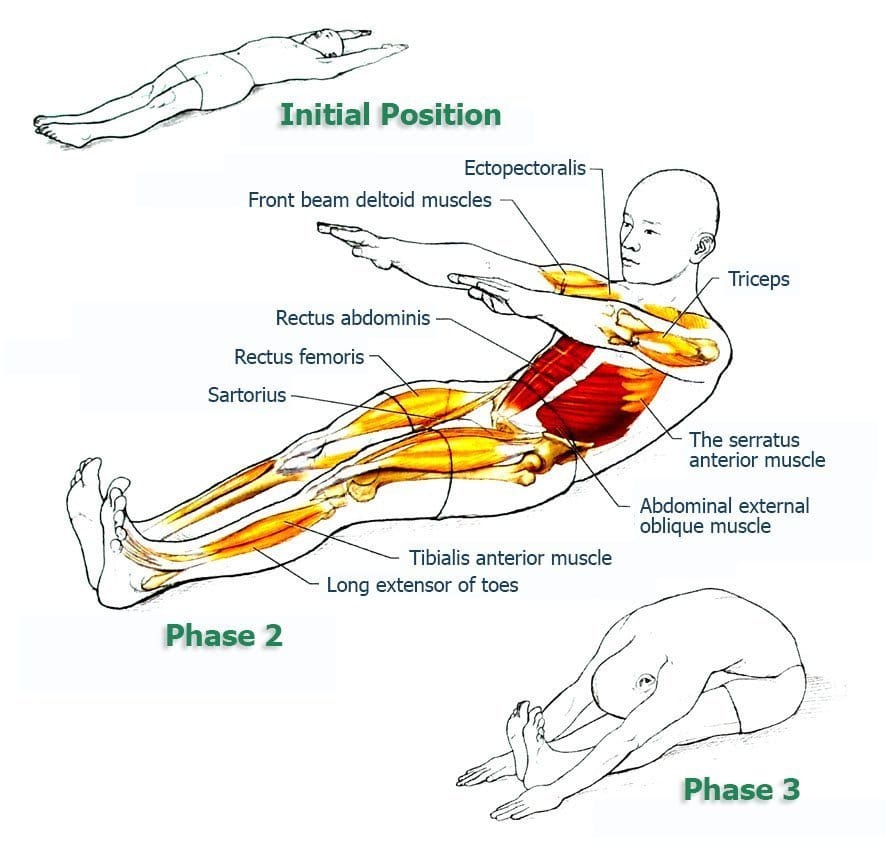Thank you for continuing to the second exercise, Roll-Up, in our program on abdominal exercises for spinal and core stabilization. Please make sure you are proficient in the first exercise of the program, Leg Circle, before advancing on here.
The series so far:
- Exercise #1: Leg Circle
- Exercise #2: Roll-Up (you are here)
- Exercise #3: Hundred
- Exercise #4: One Leg Stretch
- Exercise #5: Stretching the Hamstring
- Exercise #6: Double Leg Stretch
- Exercise #7: Crisscross
- Final Exercise: Teaser
This series are based on abdominal exercises that use your abs in a variety of modes. In today’s exercise, Roll-Up, the abdominals are used as prime movers in their action of spinal flexion as well as stabilizers while the legs remain straight, resting on the mat.
Exercise 2 – Roll-Up

Initial position. Lie on your back on an exercise mat, legs straight and together with the toes gently pointed outward. Arms are extended straight overhead and in line with the shoulders with the palms facing up:
- Inhaling, draw the abdominals inward toward the spine, lift the arms toward the ceiling and bring the chin toward the chest while lifting the head and shoulder blades off the mat. At the same time flex the feet in an ankle–foot dorsiflexion;
- Exhaling, continue to curl up, passing through a sitting position until the upper body is over the legs, with the fingers reaching toward the toes. If flexibility allows, the palms can touch the sides of the feet or be placed on the mat as shown on the End of Phase 3 on the illustration;
- Inhaling, begin to roll down until the lower back starts to establish contact with the mat;
- Exhaling, finish rolling back down to the starting position, bringing the arms back overhead. Repeat the sequence 10 times.
Make Sure You:
- Focus on performing a smooth, sequential movement of every vertebrae as each one lifts off the mat (in the 2nd and 3rd phase) and lowers back onto it in (4th and 5th phase);
- At the end of the 3rd phase, concentrate on pulling the lower abdominals inwards while the hip and spinal extensors smoothly control lowering the trunk towards the legs. Try to keep the head positioned between the arms and make sure the heels are in constant contact with the mat;
- Arms are always kept straight by using the elbow extensors. Try to activate the scapular depressors to avoid elevating the shoulder blades. Arms move at the shoulder joints, with the shoulder extensors bringing them forward in the 2nd phase and the shoulder flexors preventing the arms drop toward the mat in phase 3 and 4 and then starting to bring the arms overhead in the 5th phase;
- Mental image: I the 3rd and 4th phase, imagine curling around a large exercise ball so the contraction of the abdominals keeps the back from flattening or arching as the hip flexors become more active and the chest moves.
Additional Notes
Roll-Up challenges the abdominals and works on spinal articulation. Abdominal exercises play a key role in providing stability and movement precision of the spine. The straight-leg position makes it more difficult for some people to achieve the posterior pelvic tilt and lower spine flexion that naturally accompany rolling up from a supine position. However, this straight-leg end position also offers a potential benefit of improving hamstring and lower back flexibility.
Modifications
If you are unable to come to a sitting position without the legs leaving the mat, you can place small cuffs (maximum of 3 pounds each) on the ankles, or you can bend the knees slightly and place the hands on the thighs to help lift the upper trunk.

